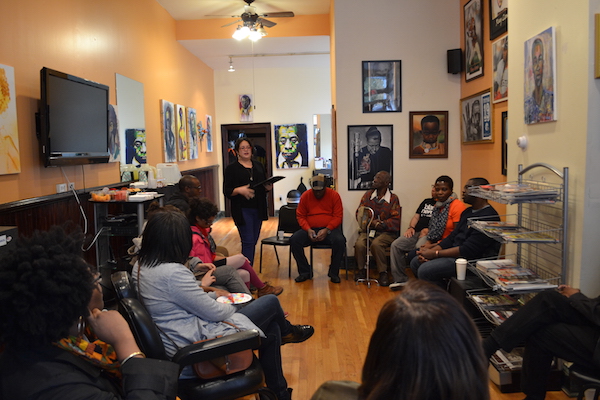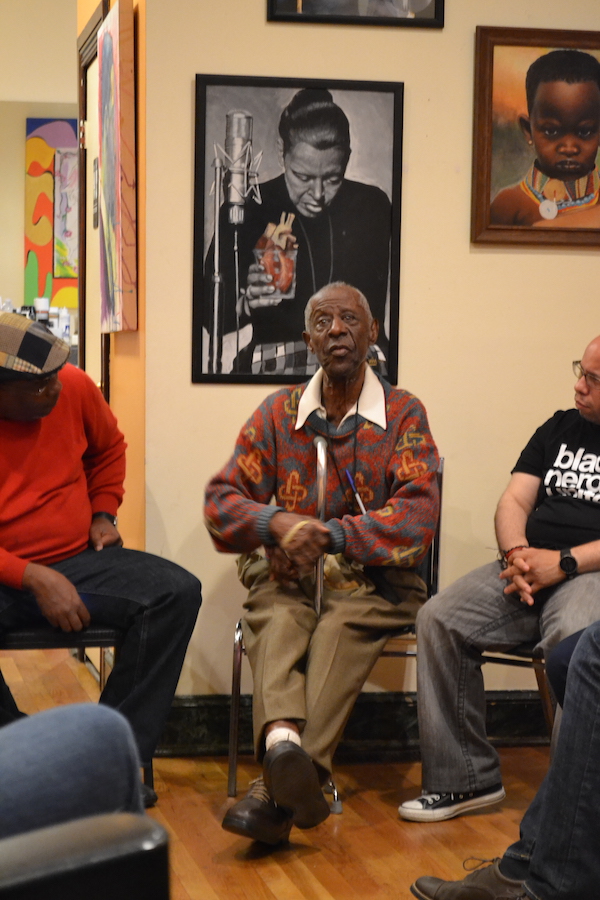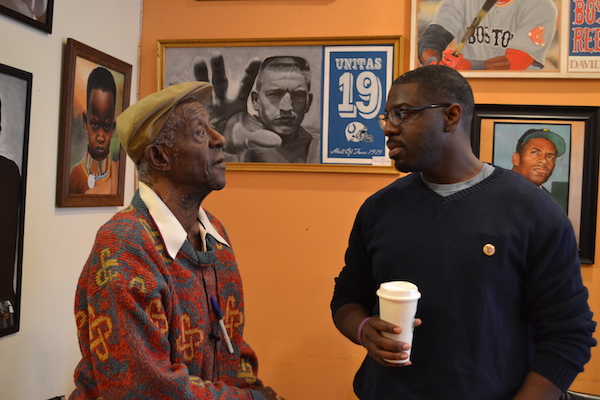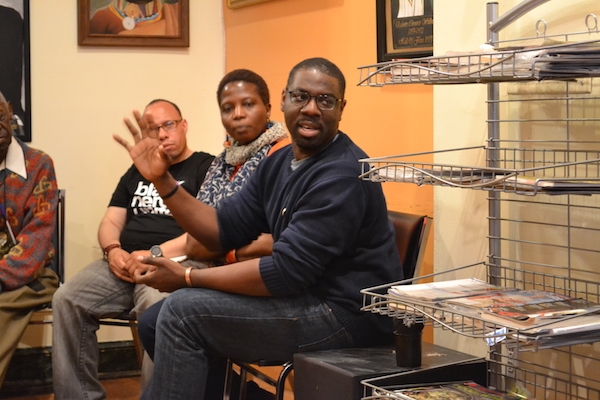Opinion Editorial: Ernest Shaw on the Barbershop Talk Series & Why Talking About the Racial Divide in Art Matters
The necessity to cultivate secret and sacred spaces has been synonymous with the African American experience long before the term African American was even conceived. The creation of these spaces has served as a survival tactic against the attempts of a white patriarchal supremacist system to dismantle the many things that culturally make Black Folk African. The barbershop is such a place where men, predominately, are allowed to exercise their right to explore the highest levels of consciousness, intellect, brotherhood, scholarship, and service. New Beginnings Barbershop and Gallery, managed by master barber Troy Staton, is as vital to its Baltimore community as a ring shout to the plantation praise house.
On October 24, I attended a barbershop talk at New Beginnings Barbershop. Entering the shop a few minutes after the start of the scheduled talk brought back memories of myself as a child, tiptoeing into Sunday school late at Immaculate Conception Roman Catholic Church on Druid Hill Avenue. There was an offense in the air for not being exactly on time for such an important event. That could have been, and probably was, all in my head.
Having said that, the atmosphere was calm and pleasant. The walls were covered with exquisite artwork from a number of artists, both professional and emerging. The venue did not perpetuate that sterile appeal some barbershops can project. This shop is much more stylish with its spiral staircase, ceiling high bookshelves, and earth tone color scheme.
“How do you perceive yourself? How do you think the world perceives you?” asked Michelle Ivette Gomez, an independent curator, arts organizer, and the moderator of the discussion.
This was an interesting way to begin a racialized dialogue on the art scene in Baltimore influenced by Cutz: Black Men In Focus, an exhibit of photographs by Gracie Xavier, an artist originally from Haiti. These questions were directed toward artists Gracie Xavier and Baltimore-based painter Stephen Towns, long time community activist Paul Booth Sr., Muse 360 board member Donald Malcolm Smith, and host Troy Staton.

The moderator, Michelle Gomez, required introspection even from the beginning, setting the table for a more intimate discussion considering the potential complexities of racialized conversations. When dealing with issues of race and ethnicity, it’s always best to start the dialogue from the “me, my, or I” perspective. This decreases the use of generalizations and stereotypes to construct one’s argument, allowing for a more authentic and progressive discussion.
Mr. Booth’s response to the opening question was the most thought provoking. As a lifelong civil rights activist and organizer well into his nineties, Mr. Booth reflected on his God-ordained life’s mission, his service to his fellow human beings. He mentioned that he is coming to his end on earth, but Mr. Booth expressed gratitude for having worked with his share of good people.
Gracie Xavier asked these very same questions of her subjects highlighted in the Cutz exhibit that inspired the barbershop talk. The photographer’s ambition was to create a digital survival guide for young African American males that not only highlighted the issues that affect Black men, but also celebrated their experiences in all the ways a mug shot cannot. In an attempt to find subject matter she decided to venture into the barbershop. “Not everyone goes to church but, most men go to the barbershop,” explained Xavier.
It become apparent that Gracie Xavier is using her artwork to facilitate social change and awareness. According to Donald Malcolm Smith, “art can be our AK47.” That is a powerful statement. He sees art as a weapon, not simply a tool, alluding to the fact that we are at war, although with whom or what remains to be seen. He stated that art is a medium for achieving social justice and change.

Smith strongly believes that Black Folk must change the narrative surrounding Black Men–for ourselves and for the well-being of our community. Smith invoked writers James Baldwin, Ralph Ellison, Langston Hughes and Amiri Baraka, saying that their work sought to redefine the way we think about ourselves. This new paradigm has led to self-determination or Kujichagulia, one of the seven principles of Kwanzaa. (Kwanzaa is an African inspired holiday practiced by many African Americans between the week of Christmas and the coming of the New Year.)
Artist Stephen Towns approached the question of art as a mechanism for social change differently. Stephen mentioned pop culture as having more of an influence on social change than art. Stephen was not alone in mentioning the influence the Cosby Show had on the shaping and reshaping of his reality in his childhood. The truth of the matter is that, for Stephen, the folks on the Cosby Show and their experiences were foreign to many if not most African Americans. However, what the show did was give us access to realities we had not been given access to previously and this was revolutionary. That is what art is all about for oppressed people. We do not have the liberty of creating art for art sake.
The Cosby Show served as a weapon against the pathology of inferiority that plagues the Black community and that’s partially why it’s no longer on air. Many people may disagree with that last statement; however, we aren’t going to stop eating five-dollar foot longs because of you-know-who, but I digress.
It was revealed midway through the discussion that the gallery that housed the exhibition had produced only three solo exhibitions by Black artists in its three years of existence. (It’s web archive reveals 8 Solo Exhibits total in that time). Why is that noteworthy information? Gallery CA is located at 440 E. Oliver Street, ‘da hood’, as some would call it. Greenmount West has been a crime-ridden neighborhood for decades, still struggling, like many Baltimore communities, to recover from the crack epidemic of the 80’s, disenfranchisement, marginalization, and most other problems you can name. Needless to say, it has been a predominately African American community for longer than I can remember. However, entering stage right is the Station North Arts District that has, like Manifest Destiny, expanded to include Greenmount West. With its expansion comes a bevy of noticeable eccentricities, Gallery CA being one of them.
I am not arguing for or against these cultural deviations although the tone of the Barbershop Talk changed when the moderator asked if we, artists of color, should feel the need to integrate into these spaces? These spaces are White owned and controlled galleries. I am using the term White to designate Whiteness as a cultural phenomenon as well as a socially constructed racial category.
Gracie Xavier responded immediately by proclaiming that the worst thing to happen to POC in this country was integration. Let me state that this is not a proclamation that I necessarily disagree with, however what was said next could have been perceived as a sneak dis or shots fired. Sneak dissing and firing shots are cultural practices used predominantly in urban environments by young African American youth. These practices mimic, in a much more clever and subtle way, the older tradition of playing the dozens.
Xavier then stated that she did not know she was Black until she entered the U.S and that she is glad she was born in Haiti. These statements can be, and are often, perceived as offensive by African Americans. Why? The term Black is used in that context to denote ‘less than’ or ‘the other’. Often it’s difficult to detect a collective nationalism among Africans throughout the diaspora. There is no nation state, flag, anthem, art that separates African Americans from their former slave masters. Or is there? Is it more difficult to see now verses before de-segregation? Has African American language, art, culture, identity been compromised by the myth of integration? Should we stop begging for access to White spaces, and what exactly are we truly begging for? What did integration achieve?

Stephen agreed. “White people have resources, they have spaces where they can show your work with really good lighting,” said Towns. He also acknowledged the cultural disconnect that sometimes creates those uncomfortable situations that Gomez mentioned, also known as racial micro aggressions.
Donald disagreed. “We do have resources.” He further illustrated his point by telling the history of Provident Hospital in Baltimore. African Americans going door-to-door collecting nickels and dimes in the early part of the twentieth century started Provident hospital, and it lasted until the early nineties. Donald further stated, “What it boils down to is we kind of believe the White man’s ice is colder.” I found that statement to be painfully appropriate and timely considering the fact that the conversation was taking place in a space that showcased Black Art, curated by a participant in the conversation, master barber and art collector Troy Staton.
Xavier mentioned that she made a conscious decision to not show at Troy’s New Beginnings gallery space because she wanted to educate others about the Black experience. She spoke as if White spaces took better care of Black artists. I was confused. I believe this was an attempt to justify her decision to show at Gallery CA and not at New Beginnings. At this point I was furious. I felt Troy, and his efforts to expose his community to artists and their work, was being invalidated. But I kept my composure.
Like Donald said, “We have resources.” There are several Black-owned spaces in Baltimore where artists are treated with dignity and respect. Station North Arts Café, Eubie Blake National Jazz and Cultural Center, Gallery Myrtis, and New Beginnings are just a few spaces with beautiful lighting and adequate resources.
So for those artists of color who wish to continue seeking access into White controlled spaces, what are you begging for? Are you begging simply for space and representation or, is there more to the behavior that influences conscious decisions to “not” show where there may appear to “not” be the best accommodations? How long do we continue to seek validation from an entity that is fed by our inferiority?
We have to keep having art talks and pushing the conversations about racism, gentrification, and inequity of all facets in art. We have to continue to organize, seek to create our own spaces that celebrate and use art as a cultural binder, not an obstruction. I truly believe that artist of color will only gain the access and complete acceptance of White spaces when we begin to fully see the value in building and controlling ones own images, spaces, ideologies and resources.
Potentially the hardest reality for people of color to accept is that an aspect of our identity is a construction of the fantasies of the people who classify themselves as White. The lack, or denial, of this assertion causes many artists of color to continue to partner with the establishment that denies them full acceptance, expression, development and humanity.
Author Ernest Shaw is an Artist-Educator in Baltimore. Check out his work at Black Art In America.
Photos by Anthony Summers







